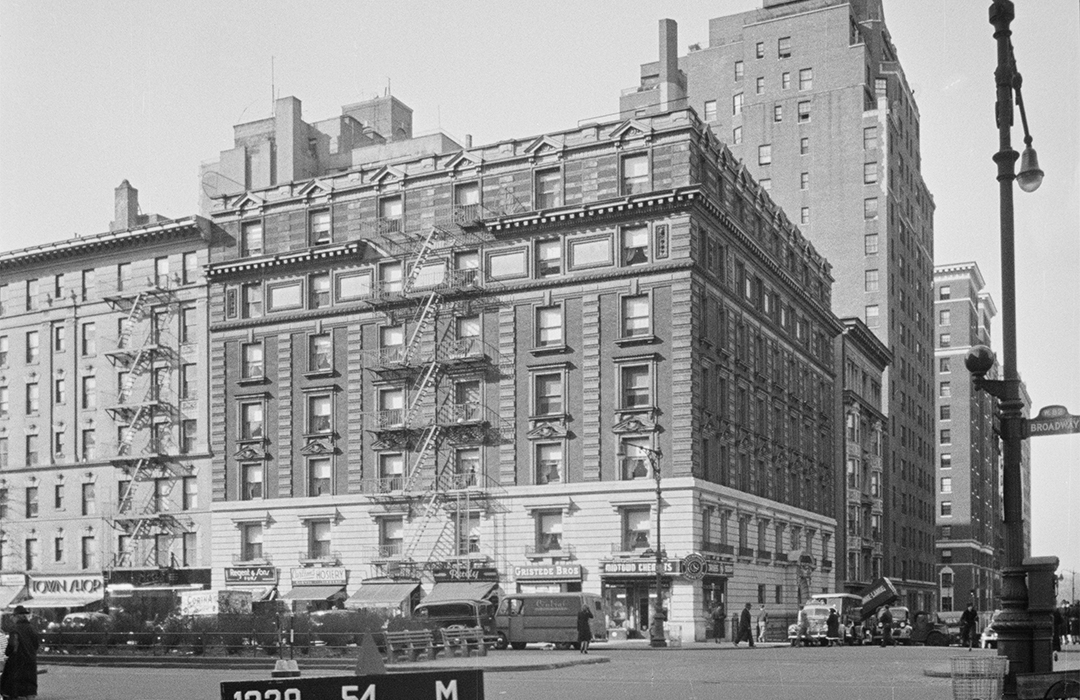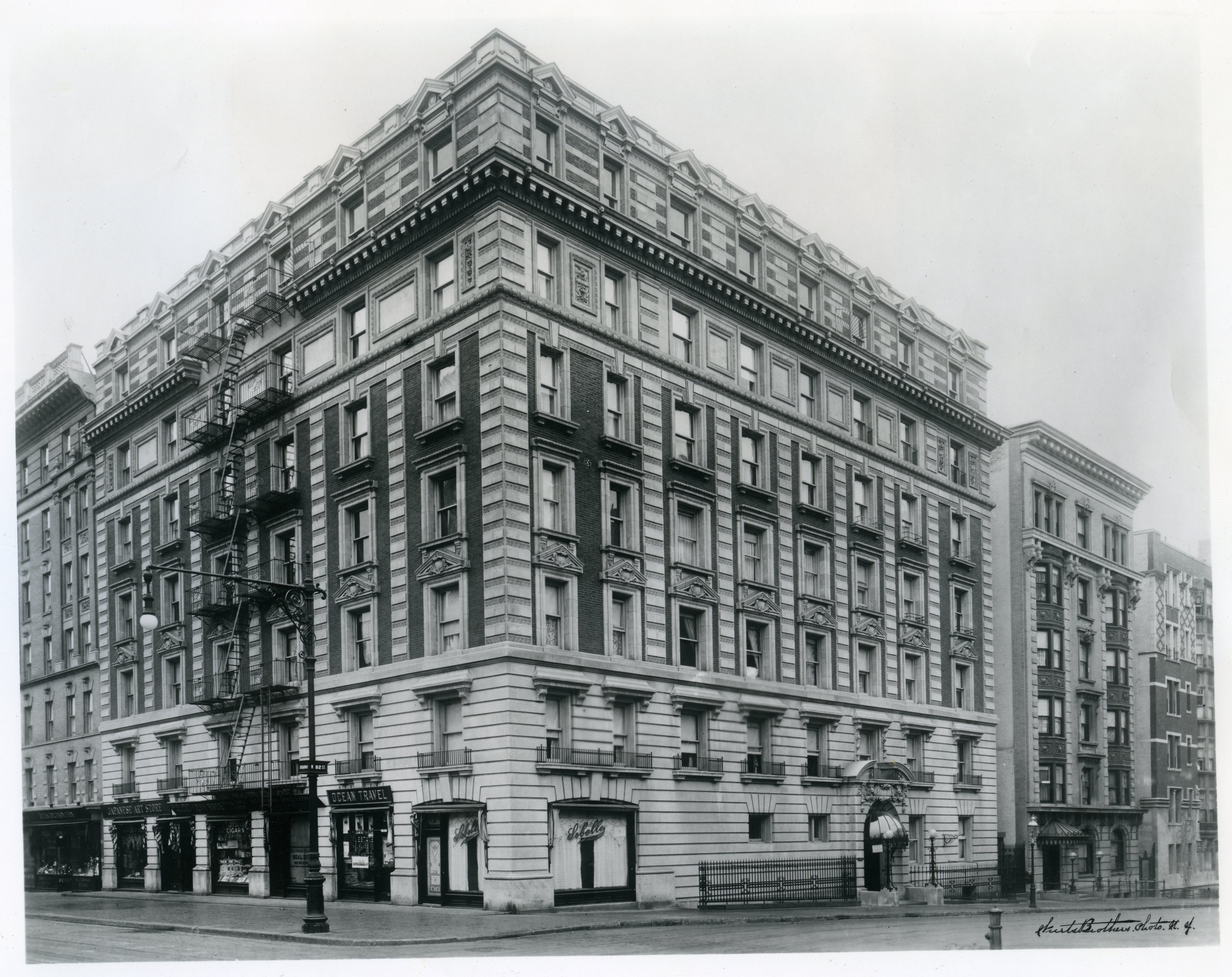
The Saxony
by Tom Miller
In 1911 Warren Cady Crane founded Ye Olde Settlers’ Association of the West Side in a panicked attempt to halt the demolition of brick and brownstone residences—most only 30 years old—to clear the way for lavish apartment buildings. But Crane was about a decade too late.
More than anyplace else in the city, residents of the Upper West Side had heartily embraced apartment house living. Massive apartments the size of private homes did away with the expense and bother of a large domestic staff.
It was a movement that developer Albert Saxe (who also spelled his name “Sachs”) recognized early on. On May 20, 1899, the Real Estate Record and Builders’ Guide announced that he had commissioned the architectural firm of Stein, Cohen & Roth to design a seven-story “brick and stone semi-fireproof flat.” The estimated cost of which was $200,000—about $6.7 million today.
The 28-year-old Emery Roth was a fledgling partner in the firm. He had worked in the office of Richard Morris Hunt until that architect’s death in 1895. He moved on to the office of Ogden Codman, Jr. who designed and decorated the homes of Manhattan’s and Newport’s socially elite. Now, working with Theodore G. Stein and E. Yancey Cohen he took on Saxe’s project. While plans were filed under the firm’s name; architectural historians agree that The Saxony would be the first apartment building designed by Roth.
The Saxony, situated on the southwest corner of Broadway and West 82nd Street, was completed in 1900. Emery Roth had produced a Beaux Arts confection of red brick and white limestone meant to reflect the social and financial status of its residents. The two-story rusticated stone base housed retail stores on the Broadway side. The residential entrance, flanked by tall lampposts and sheltered by a glass-and-iron canopy, was located on the less public 82nd Street.
The Saxony would be the first apartment building designed by Roth.
The Saxony offered the conveniences of a private home, as well as staff employed by the management—like the “liveried hall service night and day.” Each apartment consisted of “nine rooms, two bath rooms, butler’s pantries and private halls.” A 1901 advertisement boasted “The parlors are unusually attractive, being finished in white and gold; they have paneled walls, with high paneled base, and ceilings enriched with ornamental relief work, motif being Louis XVI.”
Depending on the floor, tenants would pay either $1,500 or $2,000 per year rent. The latter would translate to a significant $5,500 per month in 2022.
Among the first tenants of The Saxony was William R. Corwine, a visible member of the Merchants’ Association of New-York. Following a devastating hurricane in 1899 in Puerto Rico, he was appointed Secretary of the Central Porto Rican Relief Committee by the Secretary of War, Russell A. Alger.
Corwine was, as well, an ardent William McKinley supporter; partly based on his merchant’s point of view. On June 20, 1900, he mailed off a letter to the editor of the New-York Tribune which said, in part, “I have no doubt that if we will all pull together with a good, long, strong pull, Mr. McKinley can be re-elected by a majority that will show to the world that this Nation is alive to the changed conditions, and that we intend to make every possible effort to expand the sale of our manufactured products in every portion of the globe.”
In 1902 William R. Corwine would find himself testifying to the Congressional Committee on Ways and Means during its hearings on Reciprocity with Cuba.
When designer Gustav F. Lang moved into The Saxony in 1902, construction was well underway on another lavish apartment building next door at 254 West 82nd Street—the DeWitt Court. Designed by Neville & Bagge, it was the project of developer Jesse C. Bennett. It was the beginning of an unexpected connection between the two unrelated buildings.
In the meantime, Gustav F. Lang submitted two of his works to the Architectural League of New York’s annual exhibition that year—a “design of electric light” and a “design for plate.” Other residents at the time were Samuel Gottlieb and his wife, Julia. Julia’s widowed mother, Yvette Rothschild, had moved in with them. The 81-year-old died here in June 1902.
Peter Gardner was described by The Financial Red Book of America simply as a “capitalist.” The socially visible Chester Ingersoll Richards and his wife had moved into The Saxony from Brooklyn Heights by 1905. That year on December 17 she announced in the society pages that she was “at home” on “second Fridays until May.”
Perhaps no one in either building entertained as lavishly as did Mrs. Chester Ingersoll Richards. Her entertainments were regularly followed in the society pages. The Richards apartment was often the scene of the meetings of the Wednesday Morning Bridge and Luncheon Club. At these events society women played bridge for expensive prizes—silver picture frames, linen handkerchiefs or a “fancy bonbon box,” for instance.
On October 1, 1910, Harriett Virginia Fischer was married to T. Arthur Nosworthy, Jr. in All Angels’ Church. Her father, Bernardo F. Fischer was one of the brothers who headed the Fischer Piano Company. Following the ceremony, the reception was held in the Fischers’ apartment in The Saxony. Bernardo Franklin Fischer would die in the apartment three years later on September 13, 1913.
At the end of January 1914, Robert B. Dula purchased the Saxony and the Dewitt Court. He sold them two weeks later as a package. The informal connection of the two structures was now a marriage, one for which divorce was not in the cards. Along with doctors, bankers, and businessmen, the West Side buildings had their share of residents from the arts. Maia Bang lived in The Saxony with her husband C. E. Hohn. The internationally known violinist wrote the Maia Bang Violin Method, an instructional book still in use today. In 1919 she advertised that she “will accept a limited number of pupils” in her studio here.
And another long-term resident of The Saxony was former actress Mrs. Grace Hall Chase Kramer. She had acted with the Booth and Barrett Theatrical Company and, now retired, maintained her memberships in the Episcopal Actors Guild and the Catholic Actors Guild. She lived here with her husband Edwin G. Kramer until her death on March 29, 1932.
Despite the questionable circumstances, the Medical Examiner pronounced death due to accidental causes.
Leo S. Jacoby was an insurance salesman who lived in The Saxony for decades. Among his clients were entertainers like Al Jolson, Richard Bennett, and Harry Richmond.
A rather eye-brow-raising death occurred in The Saxony on May 6, 1921. William Becker, an electrical engineer, and his wife had divorced. Taking her maiden name, Katherine Miller now had an apartment here. That night police were called to her apartment where they found Becker dead, his wrist slashed.
According to Katherine, her ex-husband had shown up around 3:00 that afternoon. Believing him to be drunk, she said, she “did not interfere when he walked into a bedroom and shut the door.”
Four hours later she knocked on the door and, getting no response, entered. According to the New-York Tribune, “Entering the room she found that a chandelier had been broken and that her former husband’s right wrist had been cut by the shattered glass.” Despite the questionable circumstances, the Medical Examiner pronounced death due to accidental causes.
By the time Leo S. Jacoby died at the age of 92 in 1965, the buildings had been sold and resold as a package several times. They had both seen changes from their former glory days, as well. In 1945 Department of Buildings records showed that the massive apartments in The Saxony had been divided into between 21 and 23 “single room occupancy” rooms per floor.
But happier days were to come. In 1969 The Saxony was converted to, for the most part, one and two co-op apartments per floor. Today, following a 2006 renovation that resulted in three apartments per floor in both buildings, The Saxony and the DeWitt Court have recaptured their original grandeur. After having been treated as a unit by real estate men for a century, the two buildings now are physically connected by a common entrance in the former service alley. The entrance to 250 West 82nd Street has been sealed off, but SAXONY is still emblazoned in an ornately carved cartouche dripping with swags and garlands.
Tom Miller is a social historian and blogger at daytoninmanhattan.blogspot.com
Building Database
Keep Exploring
Be a part of history!
Think Local First to support the local business at 2273-2275 Broadway:
Meet Louisa Craddock!
Meet Byrna West!



